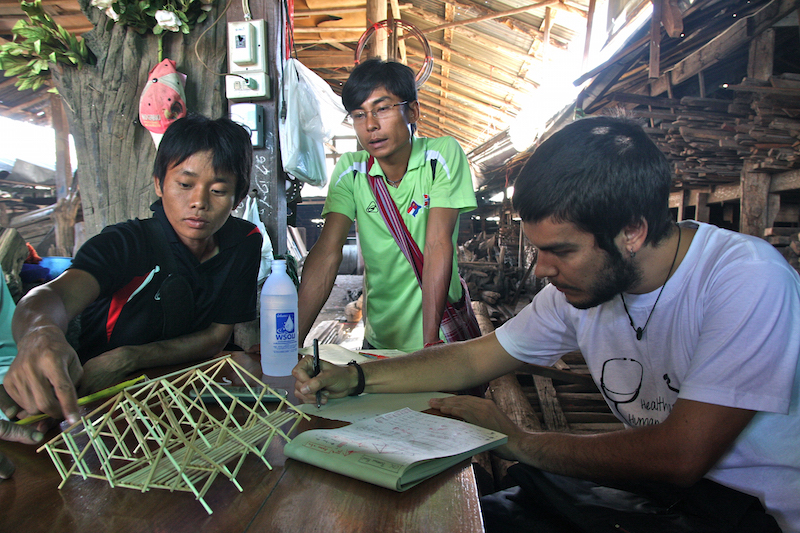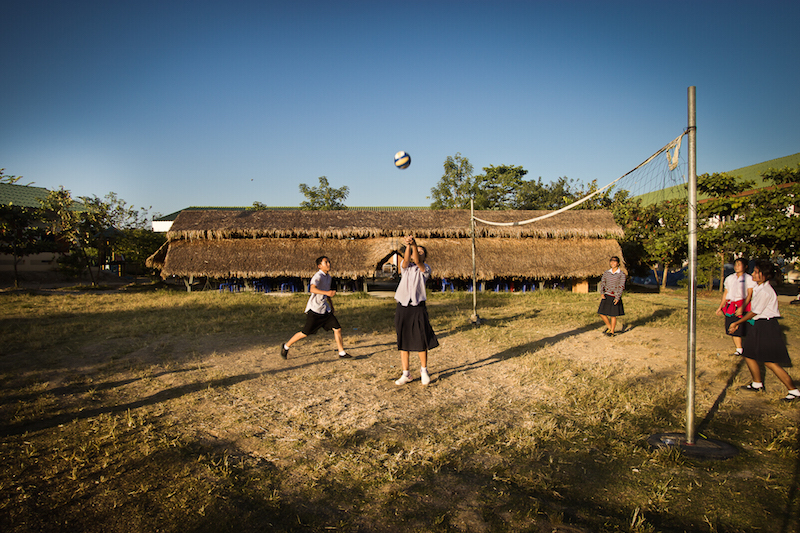#GC2022 is accepting submissions - 25d 27h 05m 44s

Temporary Dormitories for CDC School ©Franc-Pallarès-López
Making an Impact: Studio a.gor.a architects models an inclusive architecture that helps people connect and share their knowledge.
Founded in 2012 by Jan Glasmeier, Albert Olmo-Company, and Line Ramstad, a.gor.a architects is based in Mae Sot, Thailand along the Thai-Burma Border. The studio has grown through an organic process of getting involved with NGO’s, community based organizations, and Gyaw Gyaw, the name of a team of construction workers founded by Line Ramstad. In this interview, Jan Glasmeier shares a brief history of their practice along with some of the obstacles they have encountered and how they have solved them to deliver works of inspirational architecture.
Why did you get involved in the community architecture practice?
In my previous job I was working as a consultant for Arup Sport on the new national stadium in Singapore. My fiancée moved to Thailand half a year earlier because it was difficult for her to find a job over there. In Thailand, she started working for the community-based organization Mae Tao Clinic which provides free healthcare to Burmese Migrants and Refugees here on the Thai-Burma border. I traveled to Thailand in January 2012 and started working as a volunteer on a few small projects. My girlfriend had a two year contract and she wanted to extend her stay for at least another year. I had no other option, than trying to find something to do in this little border town. I met Albert, who was already based in Mae Sot for a couple of years, and together we started working on a few smaller projects within the local communities.
What does a.gor.a stand for? How was the studio founded?
The “g o r” in a.gor.a stands for the family names of the three founders. Glasmeier, Olmo-Company, Ramstad.
In 2013 we got invited to participate in an exhibition at the German Architecture Museum in Frankfurt called Think Global, Build Social so we had to come up with a name. a.gor.a architect is not a registered organization in Thailand and we are officially not allowed to call ourselves architects over here. By the way, Thai architects would have to face the same issues, if working in Europe.
How was the team formed? How did local people become involved?
In October 2012 Mae Tao Clinic was contacted by Casira, an Organization from Quebec in Canada, about the possibility to donate money but also to get involved in a four week hands-on workshop in Mae Sot. At that time Kwel Ka Baung Migrant School, the only purely Karen Migrant School, had an urgent need to move to a new location. We decided to build a new school campus with the support of Casira within one year’s time. Casira returned to Mae Sot the following year and we were able to open the new school campus right before the 2014 academic year started.

Temporary Dormitories at the timbershop ©Allyse Pulliam
For the 15 month construction process we hired local workers (some of them legal, some of them illegal migrants from Burma) from the nearby community. Due to the fact that we were designing and building the school ourselves, we had full control over the money and were therefore able to provide a decent salary to our workers. The core team of 5 local workers stayed with us for the whole length of the project and after finishing Kwel Ka Baung School we were asked to work on other migrant school projects. The team of construction workers wanted to continue building with us and we wanted to continue working with them, so we kept going and expanded the team to twelve workers at times.
How did you build trust between the community involved and your team?
It’s all about trusting and respecting each other, as well as accepting the way things work in a different environment. It’s about learning from each other and not taking things too seriously and trying to have as much fun as possible. We also pay salaries to our workers weekly (every Saturday) and have not yet missed it once.
Last year we won an architecture award in South Africa, which included some prize money. This was a nice opportunity to pay an extra two weeks’ salary to the whole team.
How did the practice start? Which was the first project completed?
The first project was Mae Tao Clinic’s Training Center which included five temporary dormitory buildings, two classrooms, and a library/ office building. The two classrooms and the library were constructed with Gyaw Gyaw (a name which means “slowly slowly” in Karen), a team of construction workers founded by Line Ramstad from Norway.

Training Center Classrooms ©Franc-Pallarès-López
How has the community been involved in your projects?
Over the past almost five years we have been involved in the construction of many educational facilities within migrant communities in and around Mae Sot. Besides working with our own team of local workers, we are always trying to involve the local community by telling them the advantage of using adobe bricks or just doing a planting workshop at school with the support of the students.
There is always a good exchange of ideas between the people of the community in which we are working and our team and we are always trying include their concerns in our decision-making process.

Temporary-School CDC ©Franc Pallares Lopez
How were the first projects funded?
The first project was founded through the embassy of Luxembourg in Bangkok and the organization “Umverteilen’’ from Berlin, Germany. We never really had to do any fundraising for our projects because we have mainly been approached by NGO or private people if they were in need of a new school or other new facilities along the border.
What were the obstacles/ hurdles when forming the studio? How were they overcome?
The expectation of funders can sometimes be a problem because people who do not live here on the border don’t seem to understand local and cultural differences. There is a big top down mentality by people from the outside, who are approaching migrant communities and think that their assistance or support is needed, but actually ignoring the reality that many issues can be resolved without the interference from the outside. It is just about asking the right questions first and being respectful while doing so.
Which materials and techniques have been chosen in respect to the local social, economic and environmental aspects?
We are mainly trying to build with local material such as bamboo (untreated), eucalyptus and second hand timber from old demolished wooden houses. Our workers are very skilled at using these local resources and they know all sorts of connection details and techniques. But we have also reintroduced adobe as an alternative building material. Adobe is completely free and we would rather support local communities by producing these adobe bricks ourselves than buying concrete bricks from the next hardware shop. Adobe is a much friendlier material to work with and it is 100% environmental friendly.
How has the studio evolved from its inception to the present day?
Albert and I started working in a bar and later in a coffee shop where we met every morning and consumed way too much coffee during the day.
Our team of construction workers has grown bigger over the past few years and we frequently hire architecture students from all over the world to join our team for a period of 6 months or so.
The local Thai foundation Suvannimit offered to share their office with us for free and there is now space for five architects. Since working at Suvannimit, a Thai engineer has joined our team. He is our man on the ground when it comes to sorting out Thai contracts, construction drawings, and dealing with Thai contractors on site.
What is the long term vision of the studio?
Currently we are extending our stay year by year. Albert and I would love to keep this going as long as possible but maybe at some point we will work at different locations but still under the same name and with the same ideas. We will see, I guess!
What recommendations would you give to other architects looking to start their firm in developing countries focusing on social architecture?
We have been asked this question many times and there is not really a recipe of how start a firm that focuses on social architecture. It is all about self-motivation and making the first step.
You don’t have to travel to a developing country to find social inequality and social unfairness. A lot of concerning things are happening in front of you to which you can react as an architect.
Just open your eyes and see what is going on around you.